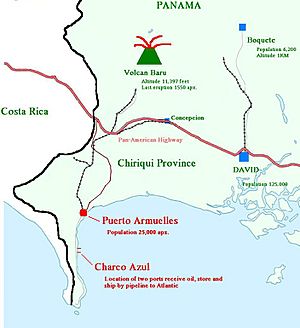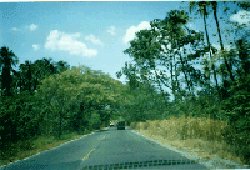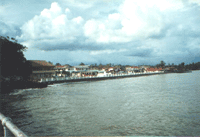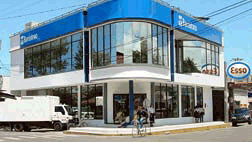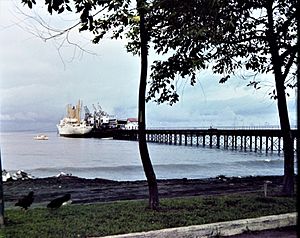Puerto Armuelles facts for kids
Quick facts for kids
Puerto Armuelles
Rabo De Puerco
El Petrolero
|
|
|---|---|
|
City and corregimiento
|
|
| Nickname(s):
The petroleum capital of Panama
|
|
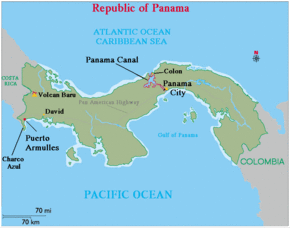
Puerto Armuelles global positioning
|
|
| Country | Panama |
| Province | Chiriquí |
| District | Barú |
| Founded | 1928 |
| City Status | 1990 |
| Government | |
| • Type | Cosmopolitan borough, City |
| Area | |
| • Land | 222.5 km2 (85.9 sq mi) |
| Population
(2010)
|
|
| • Total | 20,455 |
| • Density | 91.9/km2 (238/sq mi) |
| Population density calculated based on land area. | |
| Climate | Am |
Puerto Armuelles is a city located on Panama's Pacific coast. It is in the western part of the Chiriquí Province, very close to Costa Rica. This city is the main town of the Barú District. It is also the second-largest city in the Chiriquí province. About 20,000 people live there. Puerto Armuelles has two deep-water ports. One port is for bananas, and the other is for oil.
Contents
Discovering Puerto Armuelles
Puerto Armuelles sits right on the Pacific Ocean. The United Fruit Company started building the town in 1927. The city was named Puerto Armuelles to honor Colonel Tomás Armuelles. He was a hero from the Coto War. Colonel Armuelles was part of Panama's defense forces. He died in a train accident during the Coto War on March 18, 1921. Before its current name, the city was called "Rabo de Puerco," which means "Pigtail."
Location and Nearby Areas
Puerto Armuelles is in the Chiriquí Province of Panama. The capital city of this province is David. David is about 60 miles (97 km) away. The city is only 5 miles (8 km) from the border with Costa Rica. However, the actual border crossing is 21 miles (34 km) away at a town called Paso Canoas. Panama City is much farther, about 235 miles (378 km) away. It takes about 6 to 8 hours to drive there on the Pan American Highway.
Banana Industry and Population Changes
Puerto Armuelles used to be a major center for Chiquita Banana's business. But Chiquita left in 2003 because of problems with workers. They sold their business in Puerto Armuelles to a group of local banana workers called Coosemupar. After Chiquita left, the number of people living in Puerto Armuelles went down a lot. In 1990, there were 46,093 people. By 2000, only 22,755 people remained. In 2010, the population was 20,455.
The Coto War History
In the 1920s, Panama and Costa Rica fought a conflict called the Coto War. This war happened near Puerto Armuelles. It was a fight over a small piece of land. Panama won the war. However, in 1940, Panama gave the land back to Costa Rica. This happened after the United States helped settle the disagreement. The US decided that Costa Rica should have the land. Panama's President agreed to this decision, even though many people in Panama did not like it. Today, both Panama and Costa Rica do not have a military. They only have civil defense forces. Both countries decided this was the best way to stop military takeovers of their governments. You can find more information about this at military of Panama.
Oil Industry in Puerto Armuelles
Puerto Armuelles has jobs related to the oil industry. This is because the Panama Canal is not wide enough for very large oil tankers, called supertankers. These supertankers cannot cross the canal to reach oil refineries on the Atlantic Ocean side.
About 6 miles from Puerto Armuelles, there is a deep-water area called Charco Azul, or "Blue Ditch." This was a perfect spot to unload oil from supertankers. The oil was then put into smaller tankers, called Panamax tankers. These smaller tankers could then cross the canal.
The Oil Pipeline
Soon, it was decided that a pipeline would be better. The pipeline was built in 1982 at the same spot, which they named Petroterminales of Panama (PTP). The pipeline starts at PTP and goes across the mountains to Chiriqui Grande. Chiriqui Grande is on the Caribbean coast in the Bocas del Toro province. Pumping stations, like one in Boquete, help the oil move over the mountains. From Chiriqui Grande, supertankers are filled with oil and take it to refineries.
Plans for an Oil Refinery
There was talk about building an oil refinery near PTP. In 2006, Puerto Armuelles was considered for a new refinery. A company called Occidental was interested. At that time, it was thought the refinery would cost about $7 billion dollars. It would be able to process 400,000 barrels of heavy oil each day. This oil would come from Mexico, South America, and the Middle East. In 2009, the plans for the refinery were stopped because of a global economic slowdown. It seems very unlikely now that a refinery will be built. However, the number of oil storage tanks at PTP has increased. These tanks are so big that you can see them from Puerto Armuelles.
Earthquakes and Climate
Puerto Armuelles has experienced several Earthquakes. In July 1934 and on Christmas night in 2003, earthquakes caused deaths. On July 1, 1979, an earthquake destroyed the local high school. Luckily, school was not in session because it was a Sunday. The oil terminal also had a lot of damage, costing $2 million. A very expensive part fell into the deep water of Charco Azul and was never found.
Earthquakes are common in this area because it is part of the Pacific Rim of fire. Puerto Armuelles has tropical weather. The temperature is usually around 92°F (33°C) during the day and 72°F (22°C) at night. If it's too hot, you can go to the beach. Or you can go up the mountain to Volcán Barú. This volcano is 11,400 feet (3478 m) high and can be seen from the hills of Monte Verde.
Puerto Armuelles has been described as a "company town which lost its company." This means that when the main company (Chiquita) left, many people moved away. Young people have been moving to bigger cities, especially Panama City, for many decades. This is similar to what happens in rural areas in other countries.
The Future of Bananas
The worker's group, Coosemupar, struggled after Chiquita left in 2003. They bought Chiquita's banana operations with government help. But they did not do well and needed the Panamanian government to help them financially for many years. Coosemupar tried to sell its operations, but no new banana company wanted to take on their huge debt. Finally, the government stopped giving money to Coosemupar.
The government, like Coosemupar, wanted to sell the banana farms to a new company. In January 2012, President Martinelli and Coosemupar members signed an agreement. The government agreed to pay off Coosemupar's $19.7 million debt. This meant the 24 banana farms would go back to government ownership. The government also agreed to help the workers who lived on the farms. The plan was to sell the 24 banana farms (called fincas) to the company that would create the most jobs.
For a while, the government talked with Chiquita about coming back to grow bananas in Puerto Armuelles. But those talks did not work out. More recently, in 2016, the government started discussions with Del Monte Foods.
Roads and Port Development
During President Martinelli's time in office, money was set aside to make the road to Puerto Armuelles wider. This road would go from two lanes to four lanes. It connects Puerto Armuelles to the Pan-American Highway (called the "InterAmericana" in Panama). This highway is at Paso Canoas, which is a border town between Costa Rica and Panama.
The Panamanian government says that a main reason for this road expansion is to serve a planned deep container port near Puerto Armuelles. This new port would be for many purposes. It would have 217 storage buildings, a deep-water container area, a future port for cruise ships, and a marina. The idea is that the wider road and the new port would create a "dry canal" highway. This 4-lane highway would connect Puerto Armuelles to Chiriqui Grande on the Caribbean side of Panama. The government hopes it will have a similar positive economic effect as the "wet canal" in Panama City.
As of February 2016, about 75% of the road expansion was finished. Parts of the road, especially through the town of Progresso and most of the bridges, still needed to be widened.
Notable People
- Omar Moreno, a baseball player
See also
 In Spanish: Puerto Armuelles para niños
In Spanish: Puerto Armuelles para niños


